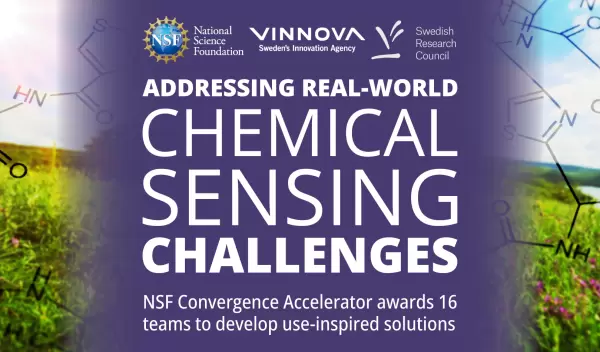
NSF spurs technology development of biological and chemical sensing applications
The U.S. National Science Foundation is investing $10.4 million to develop innovative technologies and solutions to address a wide range of challenges related to chemical and biological sensing. Through this investment, 16 multidisciplinary teams have been selected for Phase 1 awards under the NSF Convergence Accelerator's Track L: Real World Chemical Sensing Applications.
Track L also constitutes the first cooperative research activity between NSF and two Swedish government agencies advancing research and innovation—the Swedish Research Council (or Vetenskapsrådet, in Swedish) and Vinnova—following memoranda of understanding that the agencies signed in May 2023. Track L is the first cooperative research activity between the agencies in which the Swedish government will invest in Swedish researchers collaborating within one U.S.-based team.
The track builds upon a wealth of foundational knowledge and recent advances in chemical sensing, sensor technology, robotics, biomanufacturing, computational modeling and olfaction to address challenges related to environmental quality, industrial agriculture, food safety, disease detection and diagnostics, personal care, substance use or misuse and possible adversarial threats.
Air pollution-related illness costs an estimated $150 billion and is responsible for more than 100,000 premature deaths in the U.S. per year, according to the National Weather Service.
"Challenges associated with chemical signatures are often dynamic and difficult to detect, posing safety and security challenges for our nation," said Erwin Gianchandani, NSF assistant director for Technology, Innovation and Partnerships (TIP). "Today’s investment in use-inspired and translational research will accelerate the development of scalable chemical sensing and identification technologies that will operate with accuracy, reliability and speed in real-world situations."
Over the next nine months, each team will develop their initial idea into a proof of concept, identify new team members and partners and participate in the Convergence Accelerator’s Phase 1 innovation curriculum, providing fundamentals in human-centered design; team science; use-inspired research; early-stage prototyping; and communications, storytelling and pitching. At the end of Phase 1, the teams will participate in a formal proposal and pitch to demonstrate the feasibility of their solutions before applying for selection to Phase 2.
"We envision the creation of cost-effective, versatile and large-scale solutions that can monitor and analyze in real-time and can be deployable across a wide range of indoor and outdoor environments," said Douglas Maughan, head of the Convergence Accelerator program. "Through collaboration with our Swedish partners, we will also merge innovative ideas, approaches and technologies in support of these goals."
The awardees include:
- Accelerating VOC Sensor Advances and Translation by Machine Learning and Bioinspiration, led by North Carolina State University.
- AI-SLAMS: AI-driven Smart Low-cost Ammonia Sensor, led by the Georgia Tech Applied Research Corporation.
- An Integrated and Miniaturized Opioid Sensor System: Advancing Evidence-Based Strategies for Addressing the Opioid Crisis, led by Auburn University.
- An Optoelectronic Nose for Toxic Gas Detection by First Responders, led by Iridescent Sensors, Inc.
- Engineered Microbial Sensors for Assessing Water Quality, led by Columbia University.
- Field-Adaptable Chemosensor Solutions with Local Neuromorphic Intelligence, led by Teledyne FLIR, LLC.
- Field-Ready Sensing Device for Early-Stage Infectious Diseases, led by the University of Notre Dame.
- HEADLINE: HEAlth Diagnostic eLectronIc NosE, led by the University of South Florida, with Swedish researchers from Linköping University and VOC Diagnostics AB.
- Innovative Approach to Monitor Methane Emissions from Livestock Using an Advanced Gravimetric Microsensor, led by Bigelow Laboratory for Ocean Sciences.
- Innovative Chemical Microsensor Development for in Situ, Real-time Monitoring of Priority Water Pollutants to Protect Water Quality, led by the University of Minnesota Twin Cities.
- iNOSES: Intelligent Nature-inspired Olfactory Sensors Engineered to Sniff, led by Harvard University.
- Nose Computer Interfaces for Narcotics and Weapons Detection, led by Canaery, Inc.
- Portable Quantum-Enhanced Sensing and Species Identification of Bioaerosols, led by UCLA.
- Smartphone Time-Resolved luminescence Imaging and DEtection (STRIDE) for Point-of-Care Diagnostics, led by the University of Nevada, Reno.
- Translating Insect Olfaction Principles into Practical and Robust Chemical Sensing Platforms, led by Washington University in St. Louis.
- UAV-assisted Dual-comb Spectroscopic Detection, Localization, and Quantification of Multiple Atmospheric Trace-gas Emissions, led by Princeton University.
About the NSF Convergence Accelerator
Launched in 2019, the NSF Convergence Accelerator—a TIP program—builds upon NSF's investment in basic research and discovery to accelerate solutions toward societal and economic impact. The program's multidisciplinary teams use convergence research fundamentals and innovation processes to stimulate innovative idea sharing and development of sustainable solutions. For more information about the program, visit new.nsf.gov/funding/initiatives/convergence-accelerator.
About TIP
TIP harnesses the nation's vast and diverse talent pool to accelerate critical and emerging technologies and address pressing societal and economic challenges. The directorate comprises three primary focus areas: fostering innovation and technology ecosystems; establishing translation pathways; and partnering across sectors to improve U.S. competitiveness, grow the U.S. economy and engage and train a diverse workforce for future, high-wage jobs. For more information about TIP, visit new.nsf.gov/tip/latest.
